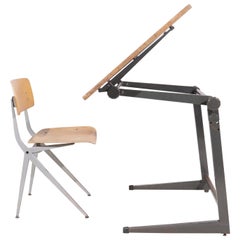Marko Drafting Table
Recent Sales
Vintage 1960s Dutch Industrial Desks and Writing Tables
Steel
Vintage 1960s Dutch Industrial Desks and Writing Tables
Steel
Vintage 1960s Dutch Industrial Desks and Writing Tables
Steel
Vintage 1960s Dutch Industrial Desks and Writing Tables
Steel
A Close Look at industrial Furniture
Industrial floor lamps, bar stools, desks and other industrial-style furnishings have experienced a resurgence in popularity with the rise of interest in minimalist design.
It's a look that celebrates the past even as it suggests vigor, productivity and brawn. The newly chic industrial style of decor repurposes the simple, sturdy furniture of an earlier world of commerce — brushed-metal storage cabinets and display shelves, task lamps and pendant lights with enameled shades, work tables with worn wooden tops and cast-iron bases — and couples them with aesthetic touches emblematic of energy and optimism, from bright upholstery fabrics to flowers.
The rise in prominence of the industrial style has come hand-in-hand with the residential repurposing of former manufacturing and warehouse districts throughout the United States, Canada and Europe. In many loft apartments created in shuttered factories, the architectural envelope has been left intact.
Industrial-style interiors feature elements like raw brick walls, exposed steel beams and oak floors whose history is written in every pit and gouge. Iron and glass transom windows give definition and interest to small kitchen areas anchored by kitchen islands made of marble, steel and brass, while taxidermy or vintage neon signs serve as wall art in living rooms dotted with leather club chairs. Patina is the keynote to a decor in sync with such surroundings.
On 1stDibs you will find industrial furniture designs that wear their age beautifully — and were built to last.
Finding the Right desks-writing-tables for You
Choosing the perfect writing desk or writing table is a profoundly personal journey, one that people have been embarking upon for centuries.
Queen Atossa of Persia, from her writing table circa 500 B.C., is said to have been the originator of the art of handwritten letters. Hers was reportedly the first in a long and colorful history of penned correspondence that grew in popularity alongside literacy. The demand for suitable writing desks, which would serve the composer of the letters as well as ensure the comfort of the recipient naturally followed, and the design of these necessary furnishings has evolved throughout history.
Once people began to seek freedom from the outwardly ornate styles of the walnut and rosewood writing desks and drafting tables introduced in the name of Queen Victoria and King Louis XV, radical shifts occurred, such as those that materialized during the Art Nouveau period, when designers longed to produce furniture inspired by the natural world’s beauty. A prime example is the work of the famous late-19th-century Spanish architect Antoni Gaudí — his rolltop desk featured deep side drawers and was adorned with carved motifs that paid tribute to nature. Gaudí regularly combined structural precision with decorative elements, creating beautiful pieces of furniture in wood and metal.
Soon afterward, preferences for sleek, geometric, stylized forms in furniture that saw an emphasis on natural wood grains and traditional craftsmanship took hold. Today, Art Deco desks are still favored by designers who seek to infuse interiors with an air of luxury. One of the most prominent figures of the Art Deco movement was French decorator and furniture designer Émile-Jacques Ruhlmann. With his use of neoclassical motifs as well as expensive and exotic materials such as imported dark woods and inlays of precious metals for his writing desks, Ruhlmann came to symbolize good taste and modernity.
The rise in appreciation for Scandinavian modernism continues to influence the design of contemporary writing desks. It employs the “no fuss” or “less is more” approach to creating a tasteful, sophisticated space. Sweden’s master cabinetmaker Bruno Mathsson created gallery-worthy designs that are as functional as they are beautiful. Finnish architect Alvar Aalto never viewed himself as an artist, but, like Mathsson, his furniture designs reflected a fondness for organic materials and a humanistic approach. Danish designers such as Hans Wegner introduced elegant shapes and lines to mid-century desks and writing tables, often working in oak and solid teak.
From vintage desks to contemporary styles, 1stDibs offers a broad spectrum of choices for conducting all personal and business writing and reading activities.

